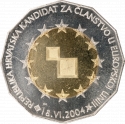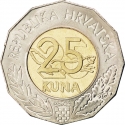You are about to finish your registration. Please check your mailbox (including spam folder). There should be a letter with a confirmation link. Check setting to make sure that your e-mail address is correct.
Send letter againDescription
The coin commemorates joining Croatia to the European Union. Croatia officially started efforts for the EU membership by signing the Stabilisation and Association Agreement in 2001, which assumed a transition period for a candidate to adjust the national law to the European one. After two years Croatia applied for the membership. On June 18, 2004 the European Council granted Croatia status of the country-candidate for the European Union. In October 2005 the EU launched the accession negotiations with Croatia, which finished on June 20, 2011. On December 9, 2011 Croatia signed the treaty of accession to the EU and in the next 18 months countries-members of the EU were gradually ratifying the treaty. The ratification procedure was accomplished on June 21, 2013 and on July 1, 2013 Croatia became the 28th member of the European Union.
Release date: 1.7.2013
Designer: Damir Mataušić
Obverse

|
The core of the coin features an image of a honeycomb symbolising the European Union. The beehive consists of twenty-seven cells, each comprising a star as a symbol of a European Union member state. The newly added, twenty-eighth cell, comprises a square with a star on it, symbolically representing the act of accession of the Republic of Croatia to the European Union as the new, twenty-eighth member. REPUBLIKA HRVATSKA ČLANICA EUROPSKE UNIJE |
|---|---|
Reverse

|
The central part of the coin's core carries the designation of the nominal value 25. Within the numeral outlines, the figure of a pine marten running towards the right is shown; the marten's body is integrated with the numeral denoting the nominal value. In the bottom, central part of the coin's ring the coat of arms of the Republic of Croatia is impressed. A blooming laurel branch is placed in a semicircle on the left to the coat of arms, while a common oak branch with fruits is on the right. The top part of the ring carries the semicircular inscription The Republic of Croatia. REPUBLIKA HRVATSKA |
| Edge |
25 Kuna
Croatia in EU
EU Membership
Subscribe series
KM# 94
Croatia in EU
EU Membership
Characteristics
| Type | Commemorative Issue (Circulating) |
| Material | Bi-Metallic |
| Ring | Cupronickel |
| Center | Copper Aluminum Nickel |
| Weight | 12.75 g |
| Diameter | 32 mm |
| Thickness | 2.2 mm |
| Shape |
|
| Sides | 12 |
| Alignment | Medal |
| Mint |
Croatian Monetary Institute (HNZ)
|





